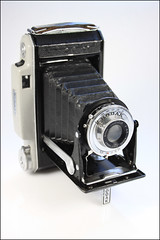Kodak Pathé
| French | () | |
|---|---|---|
| companies | ||
| AFR | Alsaphot | André and Lieutier | Angénieux | Arca Swiss | As de Trèfle | Atoms | Aubertin | Balcar | Bardin | Bauchet | Baudry | Bellieni | Berthiot | Boumsell | Boyer | Bronzavia | Cindo | Cord | Cornu | Coronet | Darlot | Demaria-Lapierre | Derogy | Faller | FAP | Fex | Français | Compagnie Française de Photographie | Gallus | Gaumont | Georges Paris | Girard | Gitzo | Goldstein | Héard & Mallinjod | Hermagis | Idam | Itier | Jousset | Joux | Kafta | Kinax | Kodak Pathé | Krauss | Lumière | Lund | Mackenstein | Manufrance | MAPED | Mazo | MFAP | MIOM | Mollier | Mundus | Olbia | Omega | OPL | Pierrat | Richard | Richard (Jules) | Roussel | Royer | SEM | Secam | SIAP | Soulé | Spirotechnique | Tiranty | Vergne | Zion (France) | ||
A bit of Pathé history
Kodak Pathé was Kodak's French plant. Like the German Kodak AG which had incorporated Nagel in 1931, Kodak France incorporated the French cine-film factory of Charles Morand Pathé in 1927. Pathé was in financial troubles with his successful French cinematographic company Pathé-Frères which made raw cine-film, phonographs, projectors, cine-cameras, records, and had a huge movie production which exported to the USA until Hollywood copied the industrial film production. Pathé had broken Kodak's raw film production monopoly, and it owned rights on some patents of Lumière. The company's 28mm cinema film wasn't as flammable as 35mm nitrate-based film.
Pathè's company may have had some experience with production of movie cameras for Pathè's own amateur film format 9.5mm which offered almost the same frame size as 16mm film at lower film cost. Pathé stayed independent, just sold 51% of his French raw-film production assets for 200 million Francs to Kodak after a personal meeting with George Eastman, but didn't give back all market shares that way, because he sold his US-American raw film plant to Dupont instead. In 1928 Pathé got under control of US-American First National - Bernhard Nathan replaced Pathé as chief. In 1939 the Pathé company went bankrupt after Nathans attempt to invest in German movie theaters, and in 1941, under German occupation, he was sued for having crashed the company. Nathan was murdered in Auschwitz in 1942.
Charles Pathé, himself an economical hazardeur, had more luck: His company was revived in 1944 with him as honorary chairman. In 1946 engineer Marcel Beaulieu left Pathé to become entrepreneur himself, making the finest amateur cine cameras. Beaulieu became in the movie sector what Leitz was in the still camera sector. Pathé ended cine-camera production in 1968. 8mm cameras had gained the consumer market, and 35mm film the cinemas.
Kodak-Pathé
Before the European Union was established France had severe laws to limit imports. Thus many Kodak Pathé cameras got lenses of French lens makers like Angénieux who made some versions of the Kodak Anastigmat for several Kodak-Pathé cameras.
Cameras

|
| Kodak 6,3 Modèle 21 w/ Angénieux Kodak Anastigmat f6.3/105 image by darerampage (Image rights) |
- 620
- A modèle 10
- A modèle 11
- modèle B11
- 6,3 modèle 20
- 6,3 modèle 21
- 4,5 modèle 30
- 4,5 Spécial modèle 31
- 4,5 modèle 32
- 4,5 modèle 33
- 4,5 modèle 34
- 4,5 modèle 36
- 4,5 modèle 37
- 4,5 modèle B31
- 3,5 modèle 40
- 3,5 modèle 42
- Brownie Flash
- Retinette
- Pony
- Pony 135
- Pony Flash
Links
|